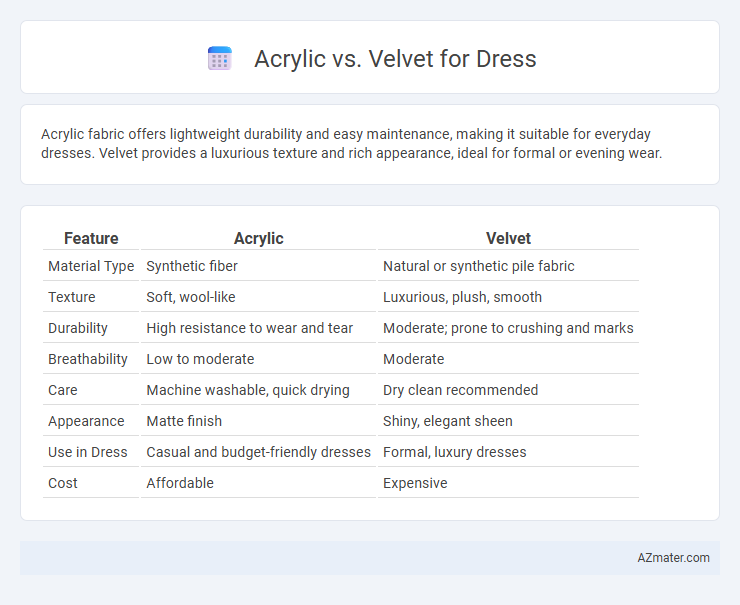Acrylic fabric offers lightweight durability and easy maintenance, making it suitable for everyday dresses. Velvet provides a luxurious texture and rich appearance, ideal for formal or evening wear.
Table of Comparison
| Feature | Acrylic | Velvet |
|---|---|---|
| Material Type | Synthetic fiber | Natural or synthetic pile fabric |
| Texture | Soft, wool-like | Luxurious, plush, smooth |
| Durability | High resistance to wear and tear | Moderate; prone to crushing and marks |
| Breathability | Low to moderate | Moderate |
| Care | Machine washable, quick drying | Dry clean recommended |
| Appearance | Matte finish | Shiny, elegant sheen |
| Use in Dress | Casual and budget-friendly dresses | Formal, luxury dresses |
| Cost | Affordable | Expensive |
Introduction to Acrylic and Velvet Fabrics
Acrylic fabric is a synthetic fiber known for its lightweight, soft texture and resistance to moisture, making it a popular choice in affordable and durable dresses. Velvet fabric, traditionally made from silk or synthetic fibers like polyester, features a distinctive dense pile that offers a luxurious feel and rich appearance ideal for elegant and formal attire. Both fabrics vary significantly in terms of texture, breathability, and care requirements, influencing their suitability for different dress styles and occasions.
Key Differences: Acrylic vs Velvet
Acrylic fabric is lightweight, breathable, and budget-friendly, making it suitable for everyday dresses, while velvet is a dense, plush material known for its luxurious texture and elegant appearance. Acrylic offers easy care and resistance to wrinkles and fading, whereas velvet requires delicate handling and often dry cleaning to maintain its rich pile and sheen. The choice between acrylic and velvet for dresses depends on the desired style, comfort, and maintenance preferences, with acrylic favoring practicality and velvet emphasizing sophistication.
Texture and Aesthetic Appeal
Acrylic fabric offers a lightweight, soft texture with wool-like warmth but tends to have a slightly synthetic feel compared to natural fibers. Velvet provides a rich, plush texture with a distinct sheen that enhances the dress's luxurious and elegant aesthetic appeal. The deep pile of velvet creates a dynamic play of light, making it ideal for formal and evening wear, while acrylic's versatility suits casual and budget-friendly options.
Comfort and Wearability Factors
Acrylic fabric is lightweight and breathable, making it comfortable for extended wear in various climates, while velvet offers a soft, plush texture that enhances comfort but may trap heat in warmer conditions. Acrylic dresses are easier to care for due to their wrinkle resistance and durability, whereas velvet requires more delicate maintenance to preserve its luxurious feel. Both fabrics provide unique comfort levels, with acrylic favoring practical wearability and velvet excelling in tactile softness and aesthetic appeal.
Durability and Long-Term Use
Acrylic fabric offers high durability and resistance to wear, making it ideal for long-term use in dresses, especially for those requiring easy care and wrinkle resistance. Velvet, while luxurious and soft, tends to be more delicate and prone to crushing, which can affect its appearance and lifespan over time. Choosing acrylic over velvet ensures sustained structural integrity and color retention for dresses subjected to frequent wear.
Maintenance and Care Requirements
Acrylic dresses require gentle hand washing or delicate machine cycles with cold water to prevent fiber damage and maintain color vibrancy. Velvet dresses need specialized care, including professional dry cleaning or careful spot cleaning to preserve the fabric's plush texture and prevent crushing. Proper storage in a cool, dry place away from direct sunlight is crucial for both fabrics to extend garment longevity and appearance.
Cost Comparison: Acrylic vs Velvet Dresses
Acrylic dresses are generally more affordable than velvet dresses due to lower production costs and synthetic fiber composition. Velvet, often made from silk or cotton blends, commands a higher price because of its luxurious texture and complex manufacturing process. Choosing acrylic offers budget-friendly options, while velvet provides premium quality with a cost premium reflective of its rich fabric and durability.
Suitability for Different Occasions
Acrylic fabric offers lightweight comfort and easy care, making it suitable for casual daywear and budget-friendly outfits, while velvet's rich texture and luxurious sheen enhance formal and evening attire, perfect for weddings, galas, and upscale events. Acrylic's moisture-wicking properties and durability support active or outdoor occasions, whereas velvet's dense pile and elegant appearance provide warmth and sophistication in cooler settings. Choosing between acrylic and velvet depends on the event's formality, climate, and desired aesthetic, with acrylic favoring practicality and velvet epitomizing opulence.
Environmental Impact and Sustainability
Acrylic fibers are synthetically produced from petroleum-based chemicals, resulting in high energy consumption and non-biodegradable waste that contributes to microplastic pollution in oceans. Velvet, often made from natural fibers like cotton, silk, or recycled materials, offers better biodegradability and lower environmental footprint when sourced sustainably. Choosing velvet made from organic or responsibly harvested fibers significantly reduces environmental impact compared to acrylic dresses.
Choosing the Right Fabric for Your Dress
Choosing the right fabric for your dress depends on the occasion, comfort, and appearance you desire. Acrylic offers a lightweight, durable, and affordable option with a smooth finish, ideal for casual or budget-friendly wear. Velvet provides a luxurious, soft texture with rich depth and warmth, making it perfect for formal events and colder seasons where elegance is a priority.

Infographic: Acrylic vs Velvet for Dress
 azmater.com
azmater.com